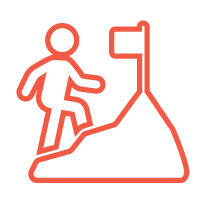Year Groups
- Primary School
- Secondary School
- Post 16

DuratioN
- Full Day
Difficulty
Adapted to the age and level of experience of students on adventure.
Min Group Size
12 People
catch the wind
Windsurfing is an exhilarating sport and fantastic way for students to enjoy the outdoors it is suitable for anyone, regardless of age or swimming ability. By harnessing the wind, students get to experience nature’s forces in action, in a super fun way, helping them to understand real-life scientific elements studied in the classroom.
We go windsurfing on reservoir waters in the Yorkshire Dales and North York Moors National Parks.
Windsurfing is a seasonal activity and is available from the Easter holidays to the October Half Term.
What’s Included
All specialist equipment
Winsurf, buoyancy aid, and water sports helmet.
All specialist clothing
Wetsuits and waterproofs when required.
Transport
Once at the centre, all transport to and from adventure activities is provided.
Experienced, full-time, outdoor teachers and tutors
Each group of 12 students is led by a fully qualified and experienced outdoor tutor.
– back in the classroom –
curriculum links
Windsurfing is an excellent way to enhance the curriculum. Many areas can be used and learnt practically such as learning how a windsurfer moves using the wind. It can cover forces and motion for science, geometry in maths, and teach water safety or be a sport for GCSE PE.
Key Stage 2
Maths: Geometry
In windsurfing, angles are used constantly. Students can learn all about the angles compared to the wind – which angles are faster, slower, and those you cannot sail in which would require changes in the angle of their sail.
History: Local
Students can learn about the history of sailing, and famous local sailors such as Captain Cook. They can also learn all about the local history of the environment in which they are sailing – why the water is there, what it is used for, and what the land around the reservoir is used for.
Key Stage 3
Science: Forces and motion
Students can learn about the forces involved in making a windsurf move, how sails work, and the forces that cause the craft to slow down. They can also explore what effects the acceleration of a windsurfer.
Geography: Human
Students can learn about where they are sailing – how this was shaped by humans, and past and present industrial activity.
Key Stage 4
P.E
Following the GCSE P.E curriculum, we can develop students skills to help them perform key windsurfing skills and maneuvers in increasingly demanding and progressive drills, in interesting and fun environments.
Hazards
Weather hazards and extreme weather events are part of the GCSE curriculum. Students can spend time talking about the types of these hazards, and how they can affect watersports.
LOCATIONS: Offered at East Barnby
YEAR GROUPS: Suitable for Primary School, Secondary School, and post 16 students

DURATION: Available as a full day activity

DIFFICULTY: Adapted to the age and level of experience of students on adventure
MIN GROUP SIZE: 12 Students
catch the wind
Windsurfing is an exhilarating sport and fantastic way for students to enjoy the outdoors it is suitable for anyone, regardless of age or swimming ability. By harnessing the wind, students get to experience nature’s forces in action, in a super fun way, helping them to understand real-life scientific elements studied in the classroom.
We go windsurfing on reservoir waters in the Yorkshire Dales and North York Moors National Parks.
What’s Included?
All specialist equipment
Windsurf, buoyancy aid and watersports helmet.
All specialist clothing
Waterproofs and wetsuits when required.
Transport
Once at the centre, all transport to and from adventure activities is provided.
Experienced, full-time, outdoor teachers and tutors
Each group of 12 students is led by a fully qualified and experienced outdoor tutor.
classroom benefits
curriculum links
Windsurfing is an excellent way to enhance the curriculum. Many areas can be used and learnt practically such as learning how a windsurfer moves using the wind. It can cover forces and motion for science, geometry in maths, and teach water safety or be a sport for GCSE PE.
Key Stage 2
Maths: Geometry
In windsurfing, angles are used constantly. Students can learn all about the angles compared to the wind – which angles are faster, slower, and those you cannot sail in which would require changes in the angle of their sail.
History: Local
Students can learn about the history of sailing, and famous local sailors such as Captain Cook. They can also learn all about the local history of the environment in which they are sailing – why the water is there, what it is used for, and what the land around the reservoir is used for.
Key Stage 3
Science: Forces and motion
Students can learn about the forces involved in making a windsurf move, how sails work, and the forces that cause the craft to slow down. They can also explore what effects the acceleration of a windsurfer.
Geography: Human
Students can learn about where they are sailing – how this was shaped by humans, and past and present industrial activity.
Key Stage 4
P.E.
Following the GCSE P.E curriculum, we can develop student’s skills to help them perform key windsurfing skills and manoeuvres in increasingly demanding and progressive drills, in interesting and fun environments.
Hazards
Weather hazards and extreme weather events are part of the GCSE curriculum. Students can spend time talking about types of these hazards, and how they can affect watersports.